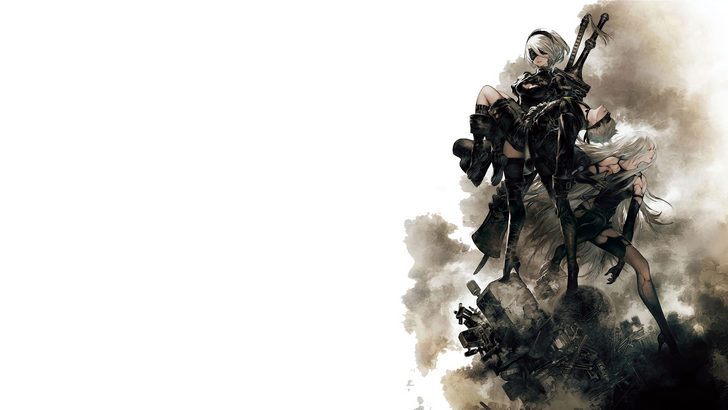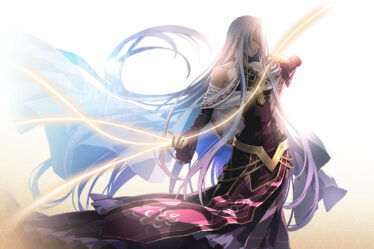
This article was originally published in Italian on GeekGamer.it in 2017.
I must admit that returning to write about a new project from the eccentric game designer Yoko Taro can’t help but make me smile. This oft-maligned creator, long associated with the reputation of the hack-and-slash Drakengard, rose to prominence thanks to the action RPG Nier, published on Xbox 360 and PS3. For years, Taro remained on the fringes of the Japanese creative industry, begging for audience attention through cross-media projects such as short theatrical performances, Japanese comic series, online stories, novellas, and even adaptations published by DC Comics.
Taro’s ability to craft interconnected and ever-expanding universes, even across decades, had to contend with Square Enix’s lackluster management of intellectual properties. The company has always preferred to spotlight the efforts of its more famous creatives at the expense of productions led by lesser-known names like Taro, Toriyama, Nomura, or Kitase. Unsurprisingly, many talented individuals have left the company over the years (think of renowned figures such as Nobuo Uematsu, Masato Kato, Tetsuya Takahashi, Soraya Saga, Yasumi Matsuno, and the list goes on…). Many of them complained about funding cuts and the company’s lack of interest in their creations, some of which are still beloved by millions of players worldwide and are often cited as examples of excellence in the JRPG field.
Yoko Taro’s story, however, took a different turn. Assigned to Cavia’s team in 2001 to create Drag-on Dragoon (Drakengard in the West), his adventure under Square Enix’s label faced a nearly decade-long interruption. During this time, the continuation of his controversial low-fantasy saga filled with dragons, cannibalism, perversion, and esotericism was handed off to other people. By a twist of fate, during this hiatus, Taro dedicated his soul to creating the first installment of Nier, a new fantasy universe branching off from one of the multiple endings of the original Drakengard, thus making it the canonical sequel. One might say it was his way of reclaiming the ownership of his debut project.
NieR: Automata directly follows the events depicted in the final epilogue of its predecessor and offers a successful mix of gameplay elements reminiscent of the past Nier action RPG created by Cavia. With the torch passed to the much more renowned authors of Bayonetta, expectations were high for the project to soar under the favorable conditions of development finally blessed by Square Enix. After witnessing the massive investments poured into promoting Final Fantasy XV, it seemed reasonable to hope that this second chapter of Nier would benefit from a significant budget. But as Yoko Taro’s games teach us, life is far crueler, and expectations are almost always disappointed.
The true value of NieR: Automata lies in its ability to honestly convey each character’s perspective, presenting a genuine existentialist manifesto that refrains from a simplistic black-and-white view of the factions involved. Instead, it delves into the clash of unattainable yet necessary ideals. These values, much like the fans’ expectations, eventually crash against the harsh surface of reality, unveiling the concept of disillusionment and accepting that game development—particularly within massive organizations like Square Enix—is marked by Nietzsche’s notion of the “eternal return.” In short: yes, NieR: Automata performs better overall than its predecessor, but it remains a project heavily constrained by mid-tier production values. Now that I’ve cleared the air and pointed out that “the graphics are ugly, the frame rate unstable, and the textures lacking,” as one might read in serious reviews, let’s move on to the game itself. Despite its ups and downs in the early hours, this game manages to stir the consciences of those holding the controller like no other recent Japanese title.
Calling upon philosophical heavyweights such as Nietzsche (a favorite among the Japanese!), Kierkegaard, and Sartre, NieR: Automata delves into the most intimate and unpleasant recesses of human nature through its protagonists, the androids 9S and 2B. I’ve deliberately avoided discussing the plot because all the events and elements recounted in the 30-40 hours it takes to see all five endings serve a purpose much greater than the simple war between scantily-clad androids and blocky biomachines portrayed in months of promotional material. Yoko Taro’s nihilistic viewpoint is clear and gains further significance as players discover the dozens of subplots told through equally numerous side missions—never have fetch quests been this compelling. There’s no room in this Square Enix title for the usual tropes of Japanese RPG storytelling. Instead, there’s a continuous revelation of elements that challenge the figure of man, who has in the meantime been elevated almost to a divine status. The balance between narrative and action phases is carefully measured, avoiding the increasingly popular trend in JRPGs of verbose but utterly empty dialogues. In NieR: Automata, conversations are relatively scarce compared to similar titles, but they’re done well. Between shmup-style bullet hell segments and lightning-speed battles, the game digs ever deeper into the contradictions we ourselves embody, pulling no punches.
NieR: Automata is a post-apocalyptic story featuring two android heroes at its core. At the same time, it’s a narrative open to multiple interpretations, distancing itself from the “emergence from adolescent malaise” theme typical of Japanese works with a similar tone, such as Neon Genesis Evangelion or Revolutionary Girl Utena. Instead, it aligns more closely with the mature existentialist ideas explored by Mamoru Oshii in his equally celebrated 1995 animated film Ghost in the Shell. From a purely narrative standpoint, NieR: Automata is so significant in the contemporary context that all other production elements become practically irrelevant.
Yet beneath the tough exterior of one of the most intelligent scripts ever featured in a Square Enix title lies the heart of an Action RPG that benefits from the contributions of PlatinumGames. What could go wrong? The reality is that, while visually satisfying with its constant burst of particle effects and light shows, the chosen battle system doesn’t fully embody the technical mastery seen in classics like Bayonetta or Metal Gear Rising: Revengeance, also by PlatinumGames. Square Enix opted to embellish the exploration of desolate environments with combat that is fast-paced and governed by the mechanics typical of real-time skirmishes, but also extremely simplified to appeal to fans of the original game.
The gameplay approach leans heavily towards button-mashing, with forgiving timing for performing the “Bayonetta-style” dodges. This accommodates newcomers but may leave more seasoned players yearning for greater challenges. For those seeking a steeper difficulty curve, there are two higher levels of difficulty, one of which is explicitly discouraged by the game itself since a single enemy hit equals instant death. While a wide variety of weapons is available, their diversity rarely significantly changes combat dynamics. Once players identify the most powerful weapons, it’s possible to reach the credits without much trouble (a tip for the impatient: equip a spear and hurl it from a distance).
At least the availability of different playable characters, each with unique abilities, offers variety in tackling the situations the game throws at you, most of which revolve around perspective-shifting gameplay. However, callbacks to other classics like Resident Evil, The Legend of Zelda, or Diablo are absent this time around.
The pods—floating ranged weapons that accompany the protagonists—proved relatively useless during my playthrough, save for one of their many available functions. It’s disappointing to admit that their utility is far less impactful compared to Grimoire Weiss—their equivalent in the predecessor—especially considering the protagonists’ significant power from the outset, which only grows stronger with upgrades via chips collected on the battlefield or purchased from vendors at android resistance camps.
No words can do justice to the meticulous artistic work carried out by Keiichi Okabe (the series’ long-time composer, currently working on the Final Fantasy XV DLC Episode Gladiolus) and Akihiko Yoshida (Vagrant Story). Their efforts could stir emotion even from a single black pixel on a white screen (and considering the hacking phases, this isn’t far from reality). The Western localization is also of exceptional quality, featuring equally outstanding Japanese and English voice tracks and a solid Italian translation. After all, this is the same company that brought us memorable sequences like this one.
Lastly, a note on how Square Enix has attempted to address the more controversial aspects of Yoko Taro’s past productions, such as the need to replay previously completed sections to unlock the true ending—a hallmark of the visual novel genre.
At the end of the first playthrough, a message from “Square Enix PR” explains that players must return as 2B and 9S to uncover more details about the story and gameplay mechanics. The almost makeshift way the company tries to bridge such a distinctly auteur-driven work with the mainstream audience it’s inevitably pitched to is amusing. In any case, each replay is enriched with character-specific missions, additional events, and the ability to skip any cinematic scenes. The third ending unlocks a chapter select feature from the title screen, allowing players to revisit specific parts of the story—a handy feature for trophy/achievement hunters or those with limited gaming time.
Ultimately, upon reaching the final epilogue—ending “E”—there’s nothing left to do but turn off the console, look up at the sky, and be grateful that creators like Yoko Taro still exist in today’s industry. Or perhaps simply be thankful that someone, somewhere, played Undertale in recent years.
NieR: Automata is the best game Yoko Taro has ever made, not so much for PlatinumGames’ contributions—which still deliver a solid Action RPG formula—but for the maturity and boldness with which it conveys certain messages and invites reflection. It’s disheartening to see Square Enix once again diverting financial resources toward IPs with entirely different priorities. Still, by the time you reach the final epilogue, none of that will matter anymore because you’ll already be part of the spark of hope for the future of Japanese entertainment.
Glory to mankind! God is dead, and Yoko Taro lives.


